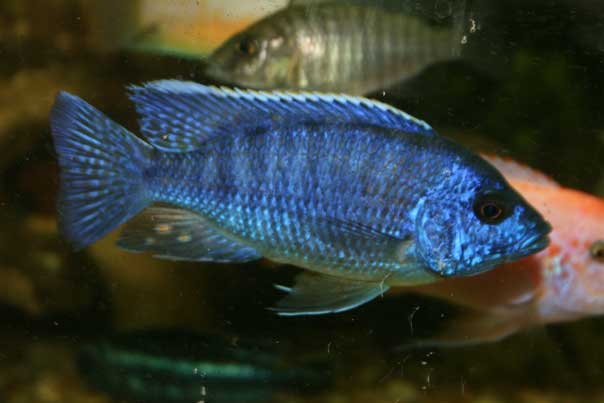The photo is a six-month ago male Blue Peacock. This fish has an interesting history and pedigree.
In 2003, after Hurricane Claudette crushed our first greenhouse in Goliad and destroyed much of our breeding stock of rainbowfishes and livebearers, we decided to expand into cichlids, especially those from Lake Malawi. These fish were popular and in high demand, largely due to the growth of the aquarium maintenance industry. Large, colorful fish were needed for stocking large tanks. Aquarium maintenance companies were searching for fish to replace marine species since salt water tanks were much more difficult to maintain remotely.
We had lots of space due to the loss of fish and because we’d built a second greenhouse. We’d been raising some Labeotropheus trewavasae in the year before (we still have this fish) and found them to work well in our system. So, we placed orders with 5D and Segrest Farms, two of the largest fish farms in Florida, for a bunch of cichlids. I ordered 100 to 150 1-2” fish of each type. These types included: Aulonocara baenschi, A. jacobfreibergi, A. nyassae, Copadichromis borleyi, Cyrtocara moorii, Iodotropheus sprengerae, Labeotropheus fuelleborni, Labidochromis caeruleus, Melanochromis auratus, M. chipokae, M. joanjohnsonae, M. johannii, Metriaclima callainos, Me. greshakei, Nimbochromis venustus, Protomelas taeniolatus, Pseudotropheus ‘acei’, P. demasoni, P. elongatus, P. estherae, P. lombardoi, P. socolofi, Sciaenochromis fryeri, and OB Peacock Cichlid. Our plan was to grow these fish up, select the best as breeders, and sell the rest. The plan worked well and we still raise and sell their descendants.
It’s the last fish listed above, the OB Peacock Cichlid, that is of interest here. The OB Peacock is some sort of aquarium strain, probably a hybrid of an Aulonocara species with other Lake Malawi cichlids. As these fish grew up, all the females were ugly mottled fish. Most of the males weren’t much better. But, a couple of the males showed some nice blue markings in between the black and muddy brown mottles, the OB pattern. I sold the other males and kept the two sort of nice males and all the females. They went into a 300 gallon breeding vat.
Their offspring included among the OB patterned fish a few non-OBs, the ancestors of the fish in the photo. OB in cichlids is a dominant gene. Apparently at least one of the males and one female carried the recessive gene for non-OB. As the fish grew up, I selected the best Blue OBs as breeders for that line, but also segregated the non-OBs into another breeding colony, choosing the males with the most blue. In a few generations we got fish that looked like the one pictured. We called them, imaginatively enough, Blue Peacocks. Today, this is a true-breeding strain and is one of our most popular fish with most of them going to aquarium maintenance companies.
In addition to the Blue Peacock we developed from the original OB Peacocks five other popular lines: Blue OB Peacocks, Orange OB Peacocks, Gold OB Peacocks, Sky Blue OB Peacocks, and Particolor Peacocks. We are presently working on Red OB Peacocks and Red Peacocks.


Leave a Reply